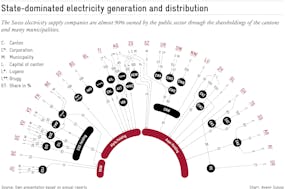With a characteristic two-year delay in the labor market, the workforce migration stemming from the European Union reacted quite vividly to the rise of the franc. In the first semester of 2017, migration reverted back to its level in 2005, time at which the free movement of persons was at its initial phase. Can this be interpreted as a decline of Switzerland’s attractiveness as a place to work and live?
By 2035, the outward flow in the workforce will have exceeded, by nearly half a million, the young people entering the labor market. Today, many take for granted the fact that this massive and imminent decrease of the local labor pool will be counterbalanced by immigrants. If this hypothesis were to be confirmed, then we are only at the beginning of a strong population growth in Switzerland (which could reach 10 million inhabitants) and the sharp decline in 2017 would only be a marginal episode. For some, this is a disturbing outlook, for others, it’s merely an economic necessity.
What if the main hypothesis regarding Switzerland’s attractiveness was unconfirmed and that we are actually victims of a biased national “collective” on the issue of immigration? Some clues point in this direction. First, the low productivity evolution of the Swiss workforce continues to lose ground to the EU (and the euro zone). In recent years, employment growth has mainly been observed at state level or in sectors close to the state. Furthermore, since 2000, even southern Europe has outdone us in terms of productivity growth despite its legendary labor market dysfunctions. A reversal of this trend is not expected.

Is Switzerland’s attractiveness simply a cliché ? (ETH Zurich library, photographic library)
Second, our neighbors are also entering an acute phase in the demographic aging of their population. The decline in the labor market will be even more substantial in Germany and Italy than in Switzerland. Almost everywhere in Europe, young workers will be much more coveted than they are today. Although young people will become more mobile and will feasibly develop part of their career in Switzerland, permanently settling in Switzerland may well become less attractive to them.
Third, Switzerland has set up protection mechanisms against the influx of foreigners based on the principle of insider-outsider. In most cases, all eyes are on the accompanying measures on the free movement of persons in the labor market, which protect nationals with less skilled jobs from foreign competition. In this context, the real estate market regulation is an extremely effective protective barrier. The principle of rent, based on costs, protects native tenants from rent increases induced by the additional demand brought about by immigrants. This refers to the rare and illiquid share of new apartments, for which rents have reached record levels. But it is not only accommodation that is expensive; the high cost of living in Switzerland is a reality. Blinded by the purchasing power abroad of the strong franc, we tend to overestimate the prosperity gap between Switzerland and its neighboring countries. The domestic purchasing power of Swiss salaries is not as high as many believe.
The influence of the small “promised land” situated in the center of the continent is not immutable. It is vital to recognize that Switzerland must address its challenges without constantly relying on additional immigration. This applies to the labor market in decline. In this particular area, digitalization may be of valuable help if we set the necessary milestones starting as of now. Better incentives for women (individual taxation and reconciliation between work and family) and training policy reforms are also necessary. This also applies to social insurances for which a sustainable funding is still not guaranteed. It would be rash to presume that a group of young highly skilled immigrants will bear the burden of our aging welfare state alone.
However, this is a widely held belief in our country. In recent years immigration has acted similarly to a drug. Most individuals have benefited from the added prosperity. Simultaneously, this success has increased the citizens’ demands, thus diverting attention from the real success factors.
In the hypothesis of future growth, we have become, contrary to all Helvetic habits, strong supporters of the state. Every so-called problem calls for new regulations and any alleged injustice, to a new redistribution. Perhaps, it is a rise in the Swiss nationalization that explains the unsatisfactory productivity.
Nobody knows whether we are close to the end of an immigration wave that will have lasted 15 years. In any case, the decreasing number of influxes creates an opportunity: there would be much to gain if the political power ceased to be used for a counter-productive debate on the free movement of persons, and instead committed to future-oriented projects.
The original version of this article was published by the NZZ in German, on September 22, 2017.





